Impact of TQM on Operational Performance
VerifiedAdded on 2020/12/09
|17
|4626
|253
Report
AI Summary
This assignment delves into the crucial link between Total Quality Management (TQM) practices and organizational operational performance. Students are tasked with analyzing scholarly articles that examine this relationship, highlighting the influence of TQM on various aspects of operational effectiveness. The analysis should draw upon research findings to demonstrate the practical implications of implementing TQM principles within organizations.
Contribute Materials
Your contribution can guide someone’s learning journey. Share your
documents today.
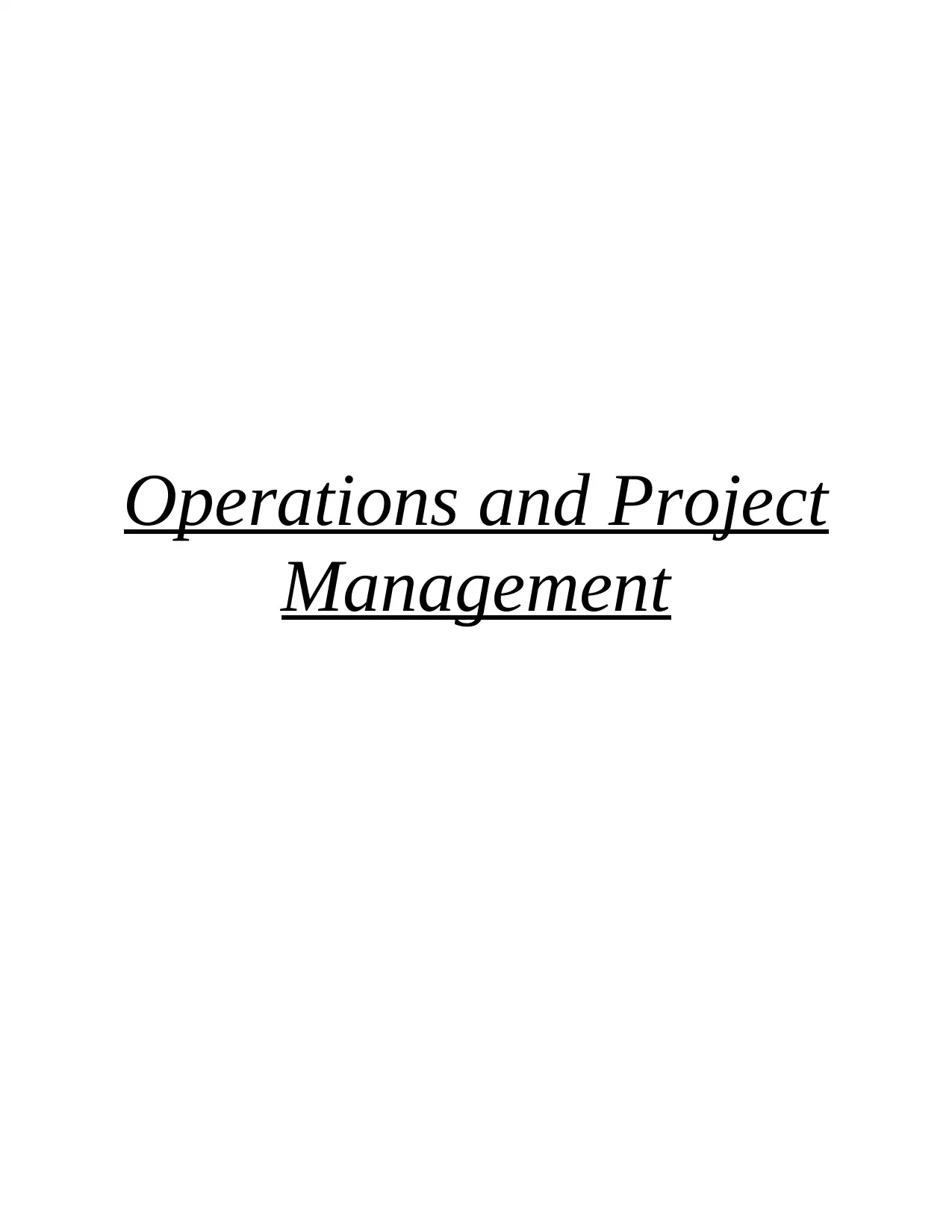
Operations and Project
Management
Management
Secure Best Marks with AI Grader
Need help grading? Try our AI Grader for instant feedback on your assignments.

Table of Contents
INTRODUCTION ..........................................................................................................................1
PART 1............................................................................................................................................1
1. Introduction to chosen organisation. .....................................................................................1
2. Explanation of operation vs operations management ..........................................................1
3. Implementation of operational management principle within Sainsbury's plc. ....................2
4. Analyse the extent to which operation management meets the requirement of an
organisation. ...............................................................................................................................3
5. Continuous improvement and lean principle..........................................................................4
6. Continuous improvement plan................................................................................................5
Recommendation.........................................................................................................................6
PART 2 ........................................................................................................................................6
A. Project Life Cycle ..................................................................................................................6
B. Review and Critique of effectiveness of PLC .....................................................................11
CONCLUSION .............................................................................................................................12
REFERENCES................................................................................................................................1
.........................................................................................................................................................2
INTRODUCTION ..........................................................................................................................1
PART 1............................................................................................................................................1
1. Introduction to chosen organisation. .....................................................................................1
2. Explanation of operation vs operations management ..........................................................1
3. Implementation of operational management principle within Sainsbury's plc. ....................2
4. Analyse the extent to which operation management meets the requirement of an
organisation. ...............................................................................................................................3
5. Continuous improvement and lean principle..........................................................................4
6. Continuous improvement plan................................................................................................5
Recommendation.........................................................................................................................6
PART 2 ........................................................................................................................................6
A. Project Life Cycle ..................................................................................................................6
B. Review and Critique of effectiveness of PLC .....................................................................11
CONCLUSION .............................................................................................................................12
REFERENCES................................................................................................................................1
.........................................................................................................................................................2
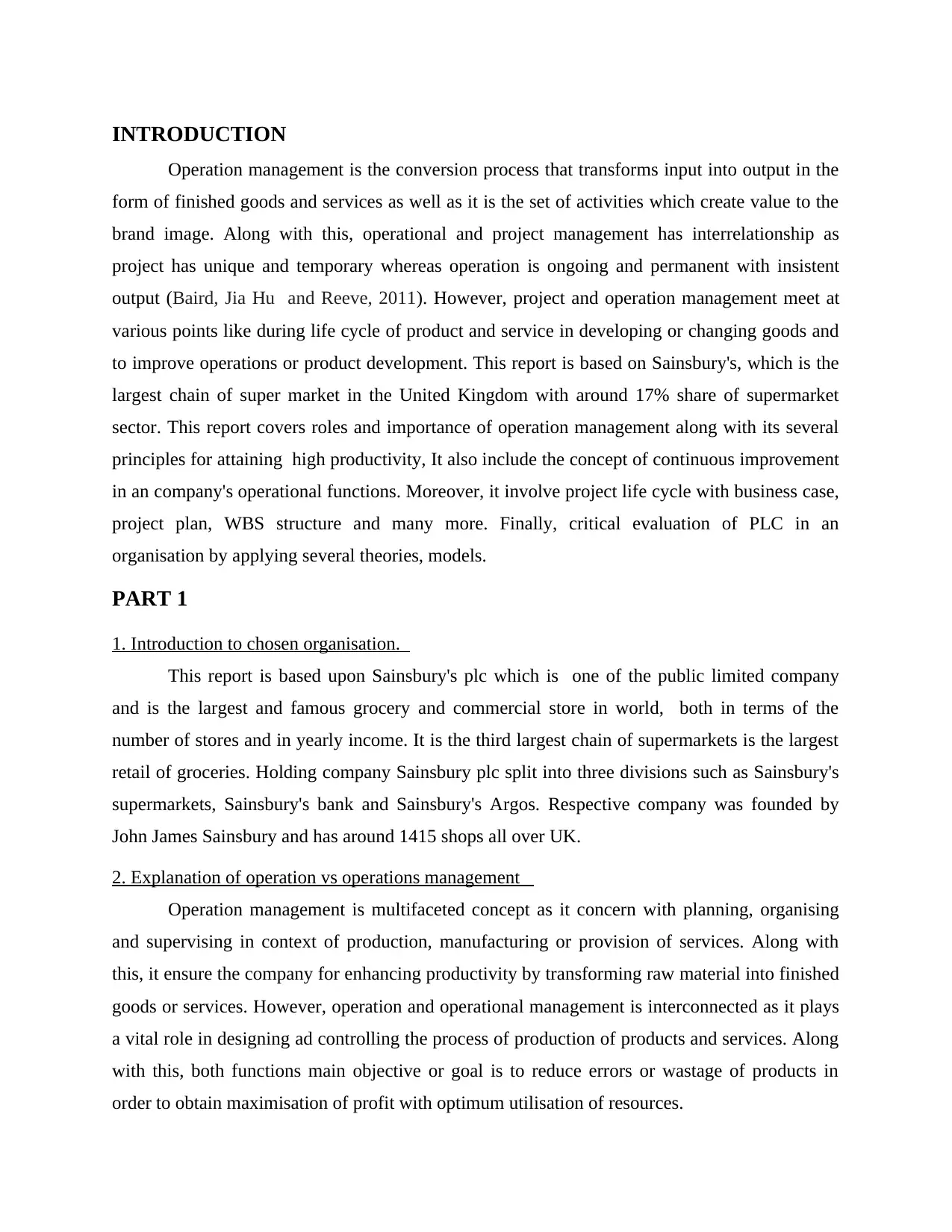
INTRODUCTION
Operation management is the conversion process that transforms input into output in the
form of finished goods and services as well as it is the set of activities which create value to the
brand image. Along with this, operational and project management has interrelationship as
project has unique and temporary whereas operation is ongoing and permanent with insistent
output (Baird, Jia Hu and Reeve, 2011). However, project and operation management meet at
various points like during life cycle of product and service in developing or changing goods and
to improve operations or product development. This report is based on Sainsbury's, which is the
largest chain of super market in the United Kingdom with around 17% share of supermarket
sector. This report covers roles and importance of operation management along with its several
principles for attaining high productivity, It also include the concept of continuous improvement
in an company's operational functions. Moreover, it involve project life cycle with business case,
project plan, WBS structure and many more. Finally, critical evaluation of PLC in an
organisation by applying several theories, models.
PART 1
1. Introduction to chosen organisation.
This report is based upon Sainsbury's plc which is one of the public limited company
and is the largest and famous grocery and commercial store in world, both in terms of the
number of stores and in yearly income. It is the third largest chain of supermarkets is the largest
retail of groceries. Holding company Sainsbury plc split into three divisions such as Sainsbury's
supermarkets, Sainsbury's bank and Sainsbury's Argos. Respective company was founded by
John James Sainsbury and has around 1415 shops all over UK.
2. Explanation of operation vs operations management
Operation management is multifaceted concept as it concern with planning, organising
and supervising in context of production, manufacturing or provision of services. Along with
this, it ensure the company for enhancing productivity by transforming raw material into finished
goods or services. However, operation and operational management is interconnected as it plays
a vital role in designing ad controlling the process of production of products and services. Along
with this, both functions main objective or goal is to reduce errors or wastage of products in
order to obtain maximisation of profit with optimum utilisation of resources.
Operation management is the conversion process that transforms input into output in the
form of finished goods and services as well as it is the set of activities which create value to the
brand image. Along with this, operational and project management has interrelationship as
project has unique and temporary whereas operation is ongoing and permanent with insistent
output (Baird, Jia Hu and Reeve, 2011). However, project and operation management meet at
various points like during life cycle of product and service in developing or changing goods and
to improve operations or product development. This report is based on Sainsbury's, which is the
largest chain of super market in the United Kingdom with around 17% share of supermarket
sector. This report covers roles and importance of operation management along with its several
principles for attaining high productivity, It also include the concept of continuous improvement
in an company's operational functions. Moreover, it involve project life cycle with business case,
project plan, WBS structure and many more. Finally, critical evaluation of PLC in an
organisation by applying several theories, models.
PART 1
1. Introduction to chosen organisation.
This report is based upon Sainsbury's plc which is one of the public limited company
and is the largest and famous grocery and commercial store in world, both in terms of the
number of stores and in yearly income. It is the third largest chain of supermarkets is the largest
retail of groceries. Holding company Sainsbury plc split into three divisions such as Sainsbury's
supermarkets, Sainsbury's bank and Sainsbury's Argos. Respective company was founded by
John James Sainsbury and has around 1415 shops all over UK.
2. Explanation of operation vs operations management
Operation management is multifaceted concept as it concern with planning, organising
and supervising in context of production, manufacturing or provision of services. Along with
this, it ensure the company for enhancing productivity by transforming raw material into finished
goods or services. However, operation and operational management is interconnected as it plays
a vital role in designing ad controlling the process of production of products and services. Along
with this, both functions main objective or goal is to reduce errors or wastage of products in
order to obtain maximisation of profit with optimum utilisation of resources.
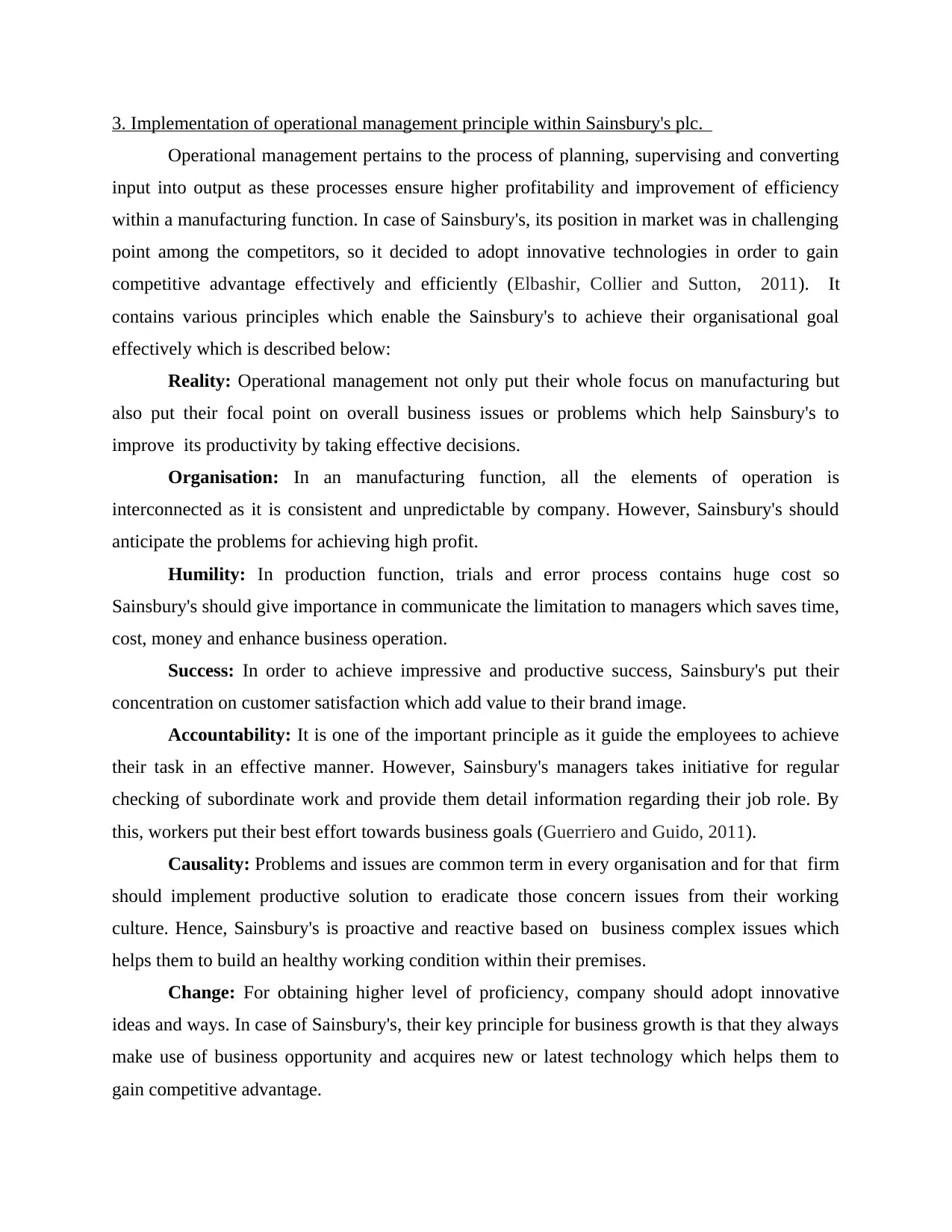
3. Implementation of operational management principle within Sainsbury's plc.
Operational management pertains to the process of planning, supervising and converting
input into output as these processes ensure higher profitability and improvement of efficiency
within a manufacturing function. In case of Sainsbury's, its position in market was in challenging
point among the competitors, so it decided to adopt innovative technologies in order to gain
competitive advantage effectively and efficiently (Elbashir, Collier and Sutton, 2011). It
contains various principles which enable the Sainsbury's to achieve their organisational goal
effectively which is described below:
Reality: Operational management not only put their whole focus on manufacturing but
also put their focal point on overall business issues or problems which help Sainsbury's to
improve its productivity by taking effective decisions.
Organisation: In an manufacturing function, all the elements of operation is
interconnected as it is consistent and unpredictable by company. However, Sainsbury's should
anticipate the problems for achieving high profit.
Humility: In production function, trials and error process contains huge cost so
Sainsbury's should give importance in communicate the limitation to managers which saves time,
cost, money and enhance business operation.
Success: In order to achieve impressive and productive success, Sainsbury's put their
concentration on customer satisfaction which add value to their brand image.
Accountability: It is one of the important principle as it guide the employees to achieve
their task in an effective manner. However, Sainsbury's managers takes initiative for regular
checking of subordinate work and provide them detail information regarding their job role. By
this, workers put their best effort towards business goals (Guerriero and Guido, 2011).
Causality: Problems and issues are common term in every organisation and for that firm
should implement productive solution to eradicate those concern issues from their working
culture. Hence, Sainsbury's is proactive and reactive based on business complex issues which
helps them to build an healthy working condition within their premises.
Change: For obtaining higher level of proficiency, company should adopt innovative
ideas and ways. In case of Sainsbury's, their key principle for business growth is that they always
make use of business opportunity and acquires new or latest technology which helps them to
gain competitive advantage.
Operational management pertains to the process of planning, supervising and converting
input into output as these processes ensure higher profitability and improvement of efficiency
within a manufacturing function. In case of Sainsbury's, its position in market was in challenging
point among the competitors, so it decided to adopt innovative technologies in order to gain
competitive advantage effectively and efficiently (Elbashir, Collier and Sutton, 2011). It
contains various principles which enable the Sainsbury's to achieve their organisational goal
effectively which is described below:
Reality: Operational management not only put their whole focus on manufacturing but
also put their focal point on overall business issues or problems which help Sainsbury's to
improve its productivity by taking effective decisions.
Organisation: In an manufacturing function, all the elements of operation is
interconnected as it is consistent and unpredictable by company. However, Sainsbury's should
anticipate the problems for achieving high profit.
Humility: In production function, trials and error process contains huge cost so
Sainsbury's should give importance in communicate the limitation to managers which saves time,
cost, money and enhance business operation.
Success: In order to achieve impressive and productive success, Sainsbury's put their
concentration on customer satisfaction which add value to their brand image.
Accountability: It is one of the important principle as it guide the employees to achieve
their task in an effective manner. However, Sainsbury's managers takes initiative for regular
checking of subordinate work and provide them detail information regarding their job role. By
this, workers put their best effort towards business goals (Guerriero and Guido, 2011).
Causality: Problems and issues are common term in every organisation and for that firm
should implement productive solution to eradicate those concern issues from their working
culture. Hence, Sainsbury's is proactive and reactive based on business complex issues which
helps them to build an healthy working condition within their premises.
Change: For obtaining higher level of proficiency, company should adopt innovative
ideas and ways. In case of Sainsbury's, their key principle for business growth is that they always
make use of business opportunity and acquires new or latest technology which helps them to
gain competitive advantage.
Secure Best Marks with AI Grader
Need help grading? Try our AI Grader for instant feedback on your assignments.
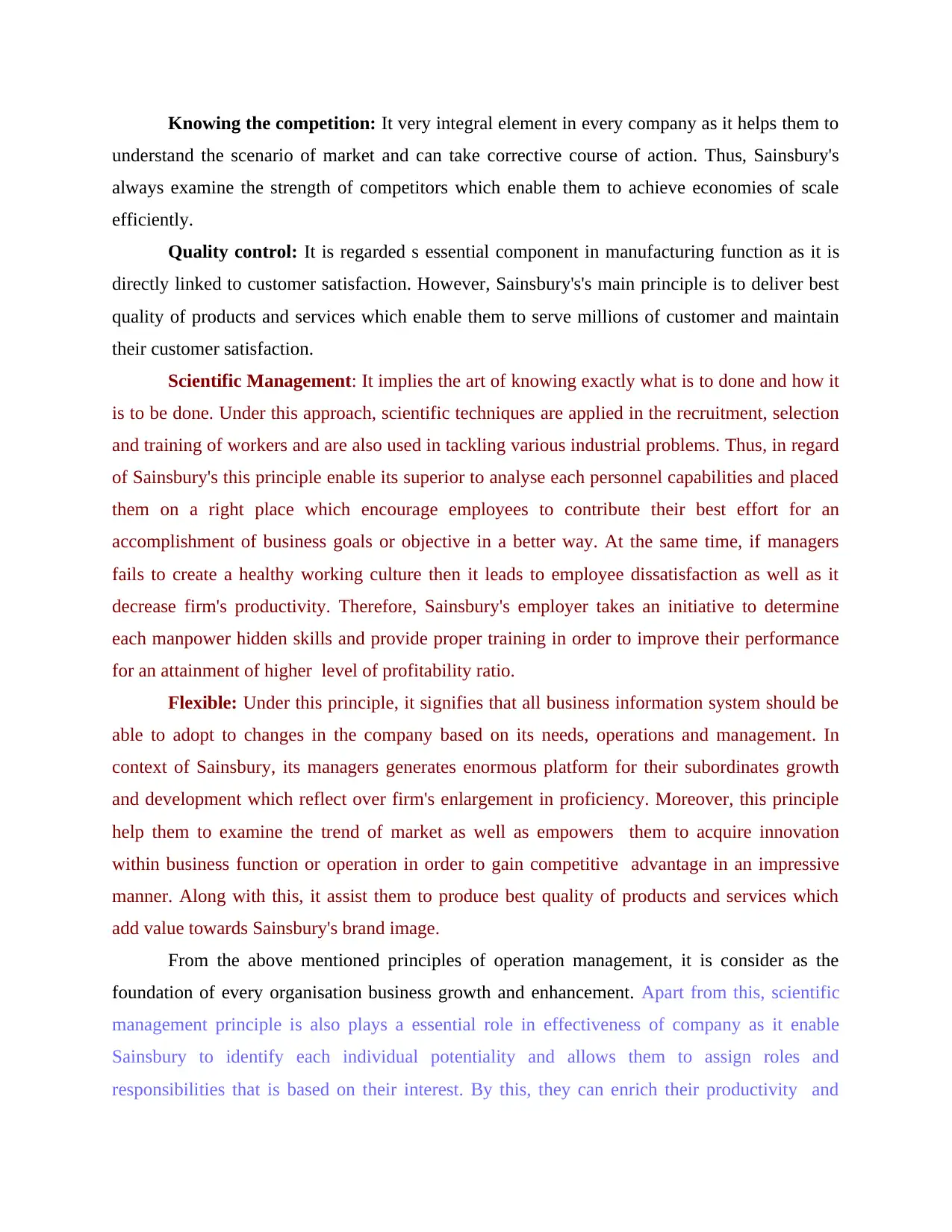
Knowing the competition: It very integral element in every company as it helps them to
understand the scenario of market and can take corrective course of action. Thus, Sainsbury's
always examine the strength of competitors which enable them to achieve economies of scale
efficiently.
Quality control: It is regarded s essential component in manufacturing function as it is
directly linked to customer satisfaction. However, Sainsbury's's main principle is to deliver best
quality of products and services which enable them to serve millions of customer and maintain
their customer satisfaction.
Scientific Management: It implies the art of knowing exactly what is to done and how it
is to be done. Under this approach, scientific techniques are applied in the recruitment, selection
and training of workers and are also used in tackling various industrial problems. Thus, in regard
of Sainsbury's this principle enable its superior to analyse each personnel capabilities and placed
them on a right place which encourage employees to contribute their best effort for an
accomplishment of business goals or objective in a better way. At the same time, if managers
fails to create a healthy working culture then it leads to employee dissatisfaction as well as it
decrease firm's productivity. Therefore, Sainsbury's employer takes an initiative to determine
each manpower hidden skills and provide proper training in order to improve their performance
for an attainment of higher level of profitability ratio.
Flexible: Under this principle, it signifies that all business information system should be
able to adopt to changes in the company based on its needs, operations and management. In
context of Sainsbury, its managers generates enormous platform for their subordinates growth
and development which reflect over firm's enlargement in proficiency. Moreover, this principle
help them to examine the trend of market as well as empowers them to acquire innovation
within business function or operation in order to gain competitive advantage in an impressive
manner. Along with this, it assist them to produce best quality of products and services which
add value towards Sainsbury's brand image.
From the above mentioned principles of operation management, it is consider as the
foundation of every organisation business growth and enhancement. Apart from this, scientific
management principle is also plays a essential role in effectiveness of company as it enable
Sainsbury to identify each individual potentiality and allows them to assign roles and
responsibilities that is based on their interest. By this, they can enrich their productivity and
understand the scenario of market and can take corrective course of action. Thus, Sainsbury's
always examine the strength of competitors which enable them to achieve economies of scale
efficiently.
Quality control: It is regarded s essential component in manufacturing function as it is
directly linked to customer satisfaction. However, Sainsbury's's main principle is to deliver best
quality of products and services which enable them to serve millions of customer and maintain
their customer satisfaction.
Scientific Management: It implies the art of knowing exactly what is to done and how it
is to be done. Under this approach, scientific techniques are applied in the recruitment, selection
and training of workers and are also used in tackling various industrial problems. Thus, in regard
of Sainsbury's this principle enable its superior to analyse each personnel capabilities and placed
them on a right place which encourage employees to contribute their best effort for an
accomplishment of business goals or objective in a better way. At the same time, if managers
fails to create a healthy working culture then it leads to employee dissatisfaction as well as it
decrease firm's productivity. Therefore, Sainsbury's employer takes an initiative to determine
each manpower hidden skills and provide proper training in order to improve their performance
for an attainment of higher level of profitability ratio.
Flexible: Under this principle, it signifies that all business information system should be
able to adopt to changes in the company based on its needs, operations and management. In
context of Sainsbury, its managers generates enormous platform for their subordinates growth
and development which reflect over firm's enlargement in proficiency. Moreover, this principle
help them to examine the trend of market as well as empowers them to acquire innovation
within business function or operation in order to gain competitive advantage in an impressive
manner. Along with this, it assist them to produce best quality of products and services which
add value towards Sainsbury's brand image.
From the above mentioned principles of operation management, it is consider as the
foundation of every organisation business growth and enhancement. Apart from this, scientific
management principle is also plays a essential role in effectiveness of company as it enable
Sainsbury to identify each individual potentiality and allows them to assign roles and
responsibilities that is based on their interest. By this, they can enrich their productivity and
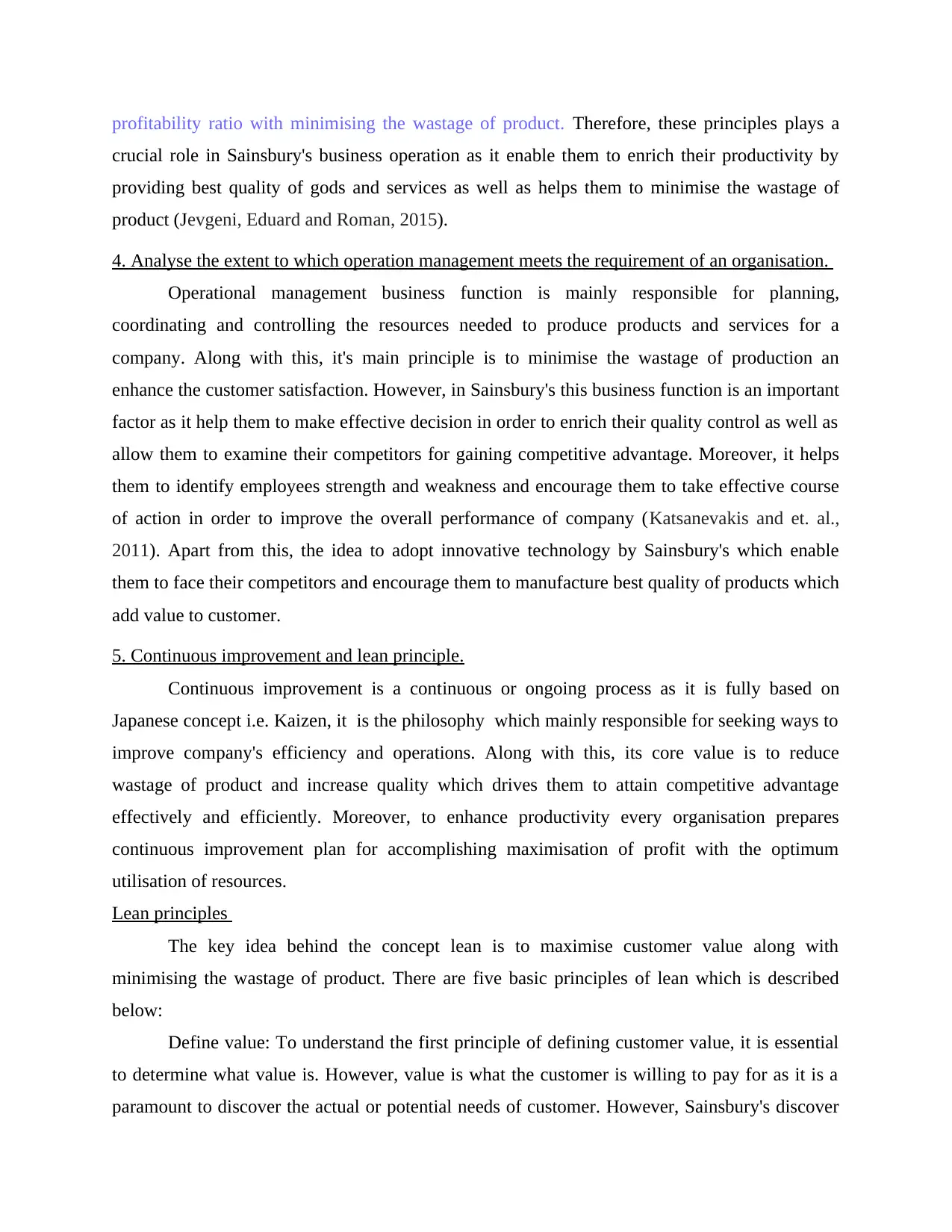
profitability ratio with minimising the wastage of product. Therefore, these principles plays a
crucial role in Sainsbury's business operation as it enable them to enrich their productivity by
providing best quality of gods and services as well as helps them to minimise the wastage of
product (Jevgeni, Eduard and Roman, 2015).
4. Analyse the extent to which operation management meets the requirement of an organisation.
Operational management business function is mainly responsible for planning,
coordinating and controlling the resources needed to produce products and services for a
company. Along with this, it's main principle is to minimise the wastage of production an
enhance the customer satisfaction. However, in Sainsbury's this business function is an important
factor as it help them to make effective decision in order to enrich their quality control as well as
allow them to examine their competitors for gaining competitive advantage. Moreover, it helps
them to identify employees strength and weakness and encourage them to take effective course
of action in order to improve the overall performance of company (Katsanevakis and et. al.,
2011). Apart from this, the idea to adopt innovative technology by Sainsbury's which enable
them to face their competitors and encourage them to manufacture best quality of products which
add value to customer.
5. Continuous improvement and lean principle.
Continuous improvement is a continuous or ongoing process as it is fully based on
Japanese concept i.e. Kaizen, it is the philosophy which mainly responsible for seeking ways to
improve company's efficiency and operations. Along with this, its core value is to reduce
wastage of product and increase quality which drives them to attain competitive advantage
effectively and efficiently. Moreover, to enhance productivity every organisation prepares
continuous improvement plan for accomplishing maximisation of profit with the optimum
utilisation of resources.
Lean principles
The key idea behind the concept lean is to maximise customer value along with
minimising the wastage of product. There are five basic principles of lean which is described
below:
Define value: To understand the first principle of defining customer value, it is essential
to determine what value is. However, value is what the customer is willing to pay for as it is a
paramount to discover the actual or potential needs of customer. However, Sainsbury's discover
crucial role in Sainsbury's business operation as it enable them to enrich their productivity by
providing best quality of gods and services as well as helps them to minimise the wastage of
product (Jevgeni, Eduard and Roman, 2015).
4. Analyse the extent to which operation management meets the requirement of an organisation.
Operational management business function is mainly responsible for planning,
coordinating and controlling the resources needed to produce products and services for a
company. Along with this, it's main principle is to minimise the wastage of production an
enhance the customer satisfaction. However, in Sainsbury's this business function is an important
factor as it help them to make effective decision in order to enrich their quality control as well as
allow them to examine their competitors for gaining competitive advantage. Moreover, it helps
them to identify employees strength and weakness and encourage them to take effective course
of action in order to improve the overall performance of company (Katsanevakis and et. al.,
2011). Apart from this, the idea to adopt innovative technology by Sainsbury's which enable
them to face their competitors and encourage them to manufacture best quality of products which
add value to customer.
5. Continuous improvement and lean principle.
Continuous improvement is a continuous or ongoing process as it is fully based on
Japanese concept i.e. Kaizen, it is the philosophy which mainly responsible for seeking ways to
improve company's efficiency and operations. Along with this, its core value is to reduce
wastage of product and increase quality which drives them to attain competitive advantage
effectively and efficiently. Moreover, to enhance productivity every organisation prepares
continuous improvement plan for accomplishing maximisation of profit with the optimum
utilisation of resources.
Lean principles
The key idea behind the concept lean is to maximise customer value along with
minimising the wastage of product. There are five basic principles of lean which is described
below:
Define value: To understand the first principle of defining customer value, it is essential
to determine what value is. However, value is what the customer is willing to pay for as it is a
paramount to discover the actual or potential needs of customer. However, Sainsbury's discover
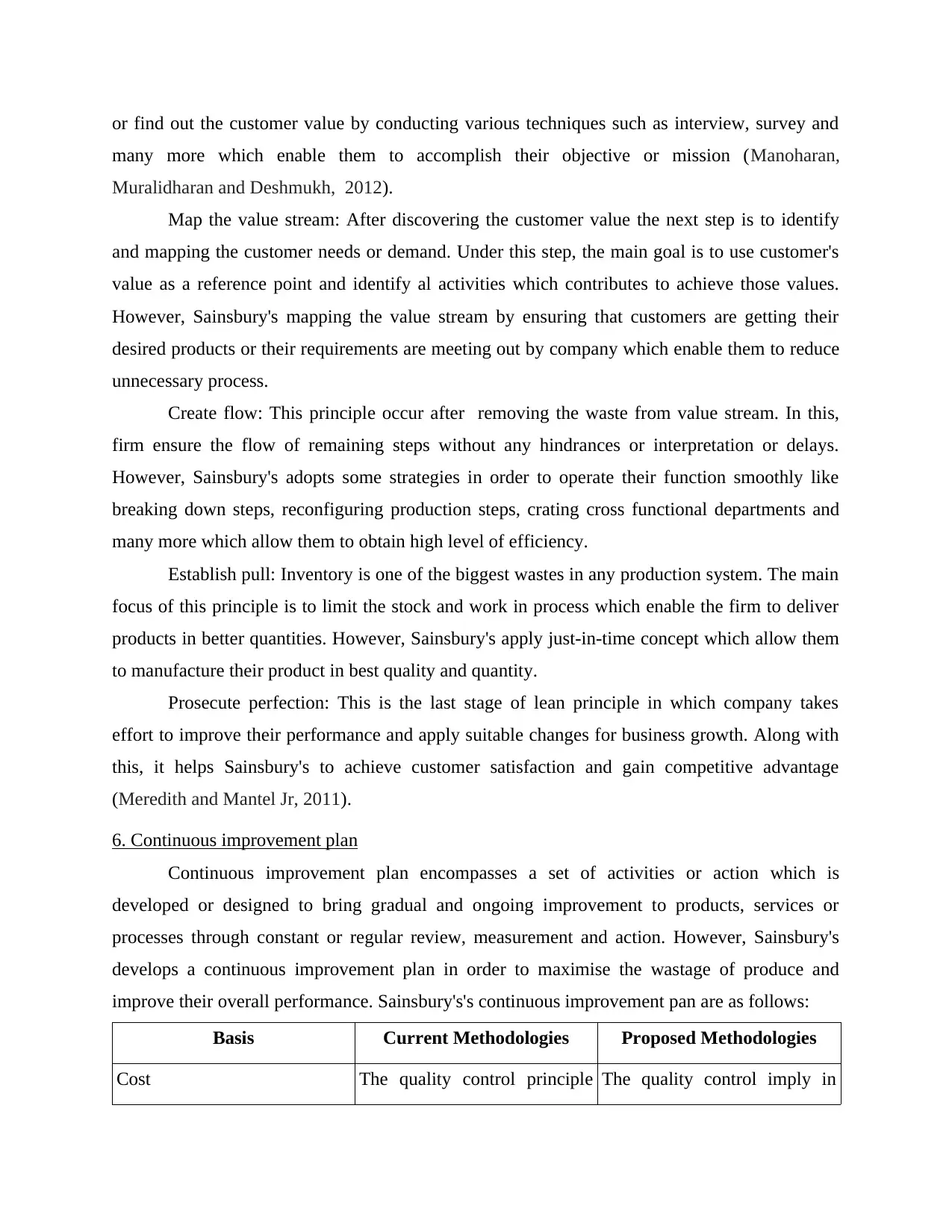
or find out the customer value by conducting various techniques such as interview, survey and
many more which enable them to accomplish their objective or mission (Manoharan,
Muralidharan and Deshmukh, 2012).
Map the value stream: After discovering the customer value the next step is to identify
and mapping the customer needs or demand. Under this step, the main goal is to use customer's
value as a reference point and identify al activities which contributes to achieve those values.
However, Sainsbury's mapping the value stream by ensuring that customers are getting their
desired products or their requirements are meeting out by company which enable them to reduce
unnecessary process.
Create flow: This principle occur after removing the waste from value stream. In this,
firm ensure the flow of remaining steps without any hindrances or interpretation or delays.
However, Sainsbury's adopts some strategies in order to operate their function smoothly like
breaking down steps, reconfiguring production steps, crating cross functional departments and
many more which allow them to obtain high level of efficiency.
Establish pull: Inventory is one of the biggest wastes in any production system. The main
focus of this principle is to limit the stock and work in process which enable the firm to deliver
products in better quantities. However, Sainsbury's apply just-in-time concept which allow them
to manufacture their product in best quality and quantity.
Prosecute perfection: This is the last stage of lean principle in which company takes
effort to improve their performance and apply suitable changes for business growth. Along with
this, it helps Sainsbury's to achieve customer satisfaction and gain competitive advantage
(Meredith and Mantel Jr, 2011).
6. Continuous improvement plan
Continuous improvement plan encompasses a set of activities or action which is
developed or designed to bring gradual and ongoing improvement to products, services or
processes through constant or regular review, measurement and action. However, Sainsbury's
develops a continuous improvement plan in order to maximise the wastage of produce and
improve their overall performance. Sainsbury's's continuous improvement pan are as follows:
Basis Current Methodologies Proposed Methodologies
Cost The quality control principle The quality control imply in
many more which enable them to accomplish their objective or mission (Manoharan,
Muralidharan and Deshmukh, 2012).
Map the value stream: After discovering the customer value the next step is to identify
and mapping the customer needs or demand. Under this step, the main goal is to use customer's
value as a reference point and identify al activities which contributes to achieve those values.
However, Sainsbury's mapping the value stream by ensuring that customers are getting their
desired products or their requirements are meeting out by company which enable them to reduce
unnecessary process.
Create flow: This principle occur after removing the waste from value stream. In this,
firm ensure the flow of remaining steps without any hindrances or interpretation or delays.
However, Sainsbury's adopts some strategies in order to operate their function smoothly like
breaking down steps, reconfiguring production steps, crating cross functional departments and
many more which allow them to obtain high level of efficiency.
Establish pull: Inventory is one of the biggest wastes in any production system. The main
focus of this principle is to limit the stock and work in process which enable the firm to deliver
products in better quantities. However, Sainsbury's apply just-in-time concept which allow them
to manufacture their product in best quality and quantity.
Prosecute perfection: This is the last stage of lean principle in which company takes
effort to improve their performance and apply suitable changes for business growth. Along with
this, it helps Sainsbury's to achieve customer satisfaction and gain competitive advantage
(Meredith and Mantel Jr, 2011).
6. Continuous improvement plan
Continuous improvement plan encompasses a set of activities or action which is
developed or designed to bring gradual and ongoing improvement to products, services or
processes through constant or regular review, measurement and action. However, Sainsbury's
develops a continuous improvement plan in order to maximise the wastage of produce and
improve their overall performance. Sainsbury's's continuous improvement pan are as follows:
Basis Current Methodologies Proposed Methodologies
Cost The quality control principle The quality control imply in
Paraphrase This Document
Need a fresh take? Get an instant paraphrase of this document with our AI Paraphraser
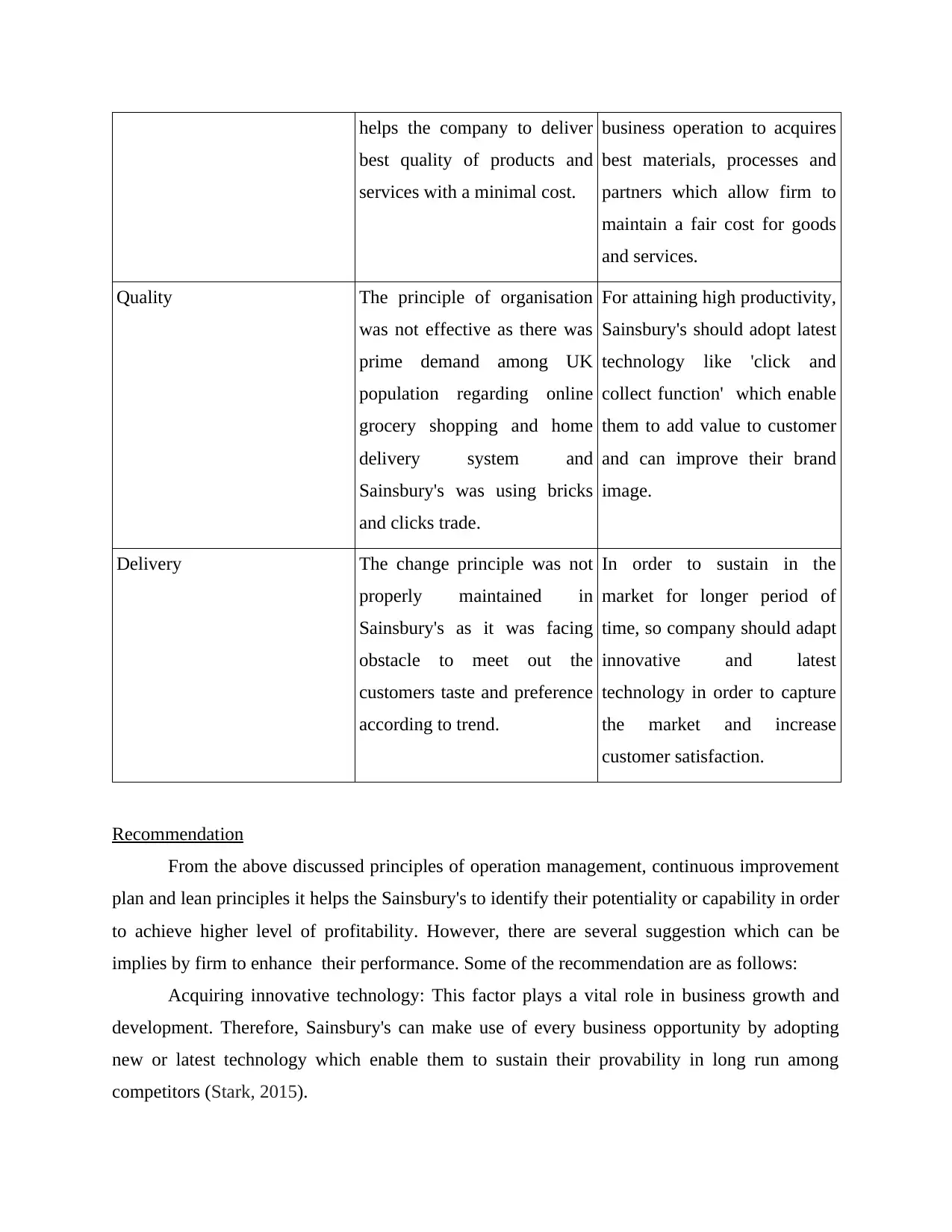
helps the company to deliver
best quality of products and
services with a minimal cost.
business operation to acquires
best materials, processes and
partners which allow firm to
maintain a fair cost for goods
and services.
Quality The principle of organisation
was not effective as there was
prime demand among UK
population regarding online
grocery shopping and home
delivery system and
Sainsbury's was using bricks
and clicks trade.
For attaining high productivity,
Sainsbury's should adopt latest
technology like 'click and
collect function' which enable
them to add value to customer
and can improve their brand
image.
Delivery The change principle was not
properly maintained in
Sainsbury's as it was facing
obstacle to meet out the
customers taste and preference
according to trend.
In order to sustain in the
market for longer period of
time, so company should adapt
innovative and latest
technology in order to capture
the market and increase
customer satisfaction.
Recommendation
From the above discussed principles of operation management, continuous improvement
plan and lean principles it helps the Sainsbury's to identify their potentiality or capability in order
to achieve higher level of profitability. However, there are several suggestion which can be
implies by firm to enhance their performance. Some of the recommendation are as follows:
Acquiring innovative technology: This factor plays a vital role in business growth and
development. Therefore, Sainsbury's can make use of every business opportunity by adopting
new or latest technology which enable them to sustain their provability in long run among
competitors (Stark, 2015).
best quality of products and
services with a minimal cost.
business operation to acquires
best materials, processes and
partners which allow firm to
maintain a fair cost for goods
and services.
Quality The principle of organisation
was not effective as there was
prime demand among UK
population regarding online
grocery shopping and home
delivery system and
Sainsbury's was using bricks
and clicks trade.
For attaining high productivity,
Sainsbury's should adopt latest
technology like 'click and
collect function' which enable
them to add value to customer
and can improve their brand
image.
Delivery The change principle was not
properly maintained in
Sainsbury's as it was facing
obstacle to meet out the
customers taste and preference
according to trend.
In order to sustain in the
market for longer period of
time, so company should adapt
innovative and latest
technology in order to capture
the market and increase
customer satisfaction.
Recommendation
From the above discussed principles of operation management, continuous improvement
plan and lean principles it helps the Sainsbury's to identify their potentiality or capability in order
to achieve higher level of profitability. However, there are several suggestion which can be
implies by firm to enhance their performance. Some of the recommendation are as follows:
Acquiring innovative technology: This factor plays a vital role in business growth and
development. Therefore, Sainsbury's can make use of every business opportunity by adopting
new or latest technology which enable them to sustain their provability in long run among
competitors (Stark, 2015).
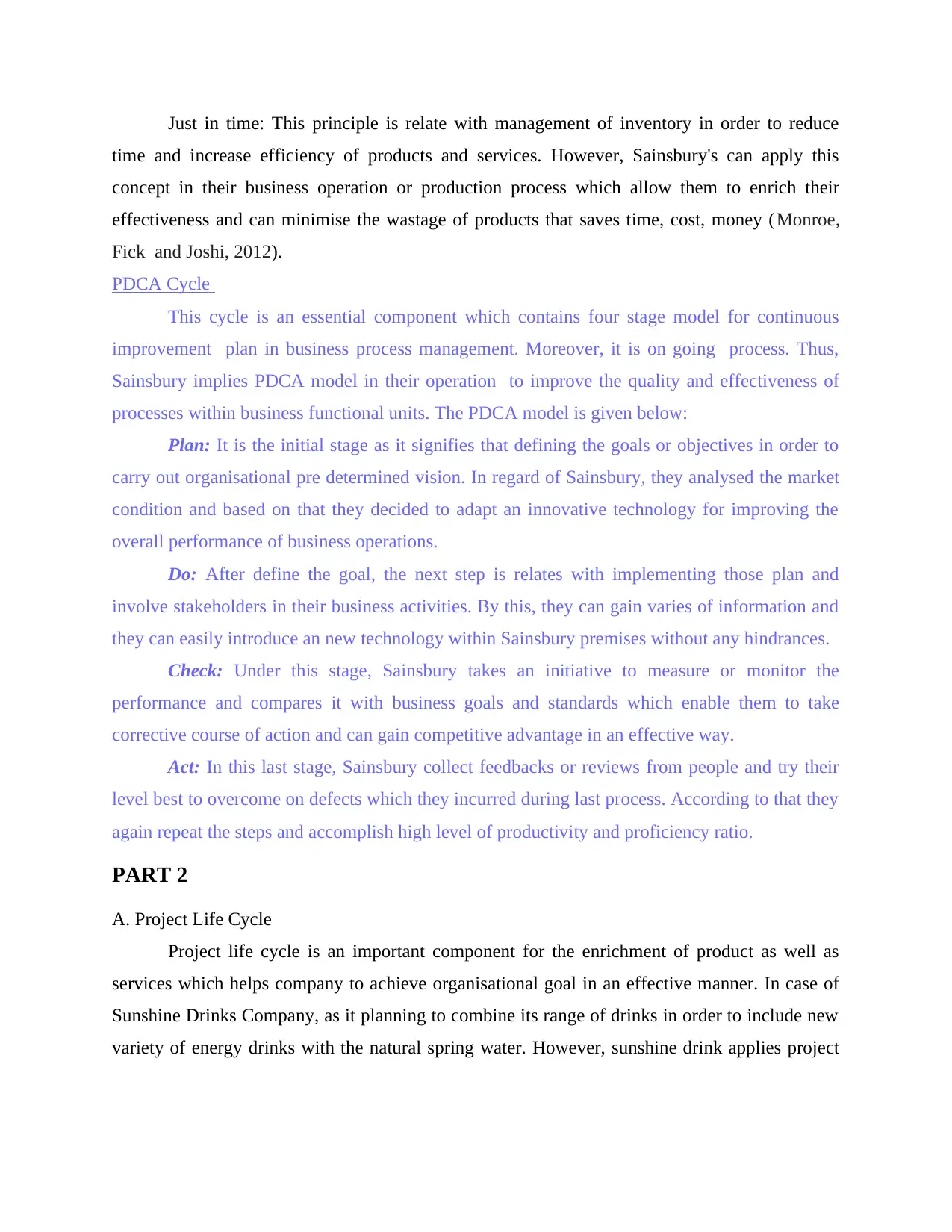
Just in time: This principle is relate with management of inventory in order to reduce
time and increase efficiency of products and services. However, Sainsbury's can apply this
concept in their business operation or production process which allow them to enrich their
effectiveness and can minimise the wastage of products that saves time, cost, money (Monroe,
Fick and Joshi, 2012).
PDCA Cycle
This cycle is an essential component which contains four stage model for continuous
improvement plan in business process management. Moreover, it is on going process. Thus,
Sainsbury implies PDCA model in their operation to improve the quality and effectiveness of
processes within business functional units. The PDCA model is given below:
Plan: It is the initial stage as it signifies that defining the goals or objectives in order to
carry out organisational pre determined vision. In regard of Sainsbury, they analysed the market
condition and based on that they decided to adapt an innovative technology for improving the
overall performance of business operations.
Do: After define the goal, the next step is relates with implementing those plan and
involve stakeholders in their business activities. By this, they can gain varies of information and
they can easily introduce an new technology within Sainsbury premises without any hindrances.
Check: Under this stage, Sainsbury takes an initiative to measure or monitor the
performance and compares it with business goals and standards which enable them to take
corrective course of action and can gain competitive advantage in an effective way.
Act: In this last stage, Sainsbury collect feedbacks or reviews from people and try their
level best to overcome on defects which they incurred during last process. According to that they
again repeat the steps and accomplish high level of productivity and proficiency ratio.
PART 2
A. Project Life Cycle
Project life cycle is an important component for the enrichment of product as well as
services which helps company to achieve organisational goal in an effective manner. In case of
Sunshine Drinks Company, as it planning to combine its range of drinks in order to include new
variety of energy drinks with the natural spring water. However, sunshine drink applies project
time and increase efficiency of products and services. However, Sainsbury's can apply this
concept in their business operation or production process which allow them to enrich their
effectiveness and can minimise the wastage of products that saves time, cost, money (Monroe,
Fick and Joshi, 2012).
PDCA Cycle
This cycle is an essential component which contains four stage model for continuous
improvement plan in business process management. Moreover, it is on going process. Thus,
Sainsbury implies PDCA model in their operation to improve the quality and effectiveness of
processes within business functional units. The PDCA model is given below:
Plan: It is the initial stage as it signifies that defining the goals or objectives in order to
carry out organisational pre determined vision. In regard of Sainsbury, they analysed the market
condition and based on that they decided to adapt an innovative technology for improving the
overall performance of business operations.
Do: After define the goal, the next step is relates with implementing those plan and
involve stakeholders in their business activities. By this, they can gain varies of information and
they can easily introduce an new technology within Sainsbury premises without any hindrances.
Check: Under this stage, Sainsbury takes an initiative to measure or monitor the
performance and compares it with business goals and standards which enable them to take
corrective course of action and can gain competitive advantage in an effective way.
Act: In this last stage, Sainsbury collect feedbacks or reviews from people and try their
level best to overcome on defects which they incurred during last process. According to that they
again repeat the steps and accomplish high level of productivity and proficiency ratio.
PART 2
A. Project Life Cycle
Project life cycle is an important component for the enrichment of product as well as
services which helps company to achieve organisational goal in an effective manner. In case of
Sunshine Drinks Company, as it planning to combine its range of drinks in order to include new
variety of energy drinks with the natural spring water. However, sunshine drink applies project
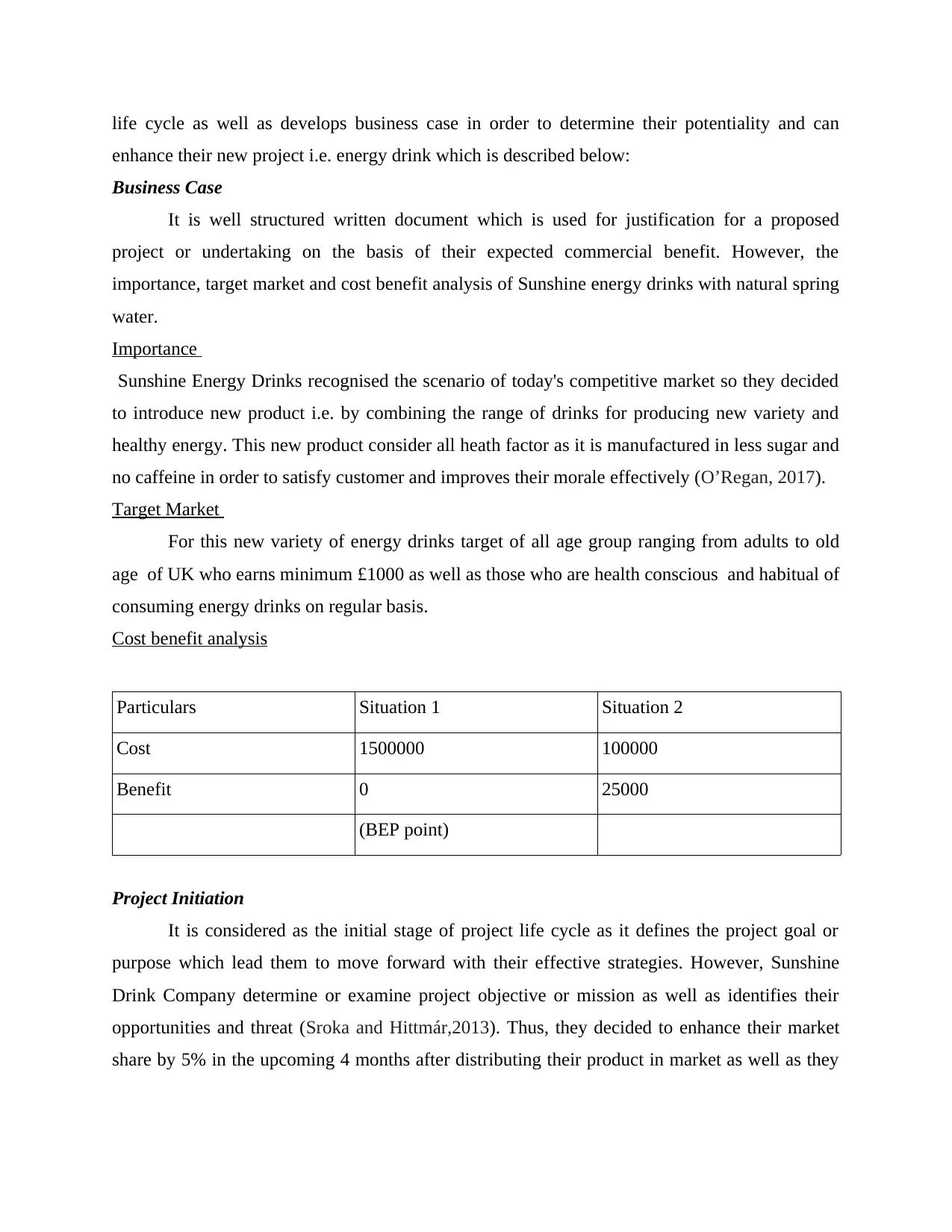
life cycle as well as develops business case in order to determine their potentiality and can
enhance their new project i.e. energy drink which is described below:
Business Case
It is well structured written document which is used for justification for a proposed
project or undertaking on the basis of their expected commercial benefit. However, the
importance, target market and cost benefit analysis of Sunshine energy drinks with natural spring
water.
Importance
Sunshine Energy Drinks recognised the scenario of today's competitive market so they decided
to introduce new product i.e. by combining the range of drinks for producing new variety and
healthy energy. This new product consider all heath factor as it is manufactured in less sugar and
no caffeine in order to satisfy customer and improves their morale effectively (O’Regan, 2017).
Target Market
For this new variety of energy drinks target of all age group ranging from adults to old
age of UK who earns minimum £1000 as well as those who are health conscious and habitual of
consuming energy drinks on regular basis.
Cost benefit analysis
Particulars Situation 1 Situation 2
Cost 1500000 100000
Benefit 0 25000
(BEP point)
Project Initiation
It is considered as the initial stage of project life cycle as it defines the project goal or
purpose which lead them to move forward with their effective strategies. However, Sunshine
Drink Company determine or examine project objective or mission as well as identifies their
opportunities and threat (Sroka and Hittmár,2013). Thus, they decided to enhance their market
share by 5% in the upcoming 4 months after distributing their product in market as well as they
enhance their new project i.e. energy drink which is described below:
Business Case
It is well structured written document which is used for justification for a proposed
project or undertaking on the basis of their expected commercial benefit. However, the
importance, target market and cost benefit analysis of Sunshine energy drinks with natural spring
water.
Importance
Sunshine Energy Drinks recognised the scenario of today's competitive market so they decided
to introduce new product i.e. by combining the range of drinks for producing new variety and
healthy energy. This new product consider all heath factor as it is manufactured in less sugar and
no caffeine in order to satisfy customer and improves their morale effectively (O’Regan, 2017).
Target Market
For this new variety of energy drinks target of all age group ranging from adults to old
age of UK who earns minimum £1000 as well as those who are health conscious and habitual of
consuming energy drinks on regular basis.
Cost benefit analysis
Particulars Situation 1 Situation 2
Cost 1500000 100000
Benefit 0 25000
(BEP point)
Project Initiation
It is considered as the initial stage of project life cycle as it defines the project goal or
purpose which lead them to move forward with their effective strategies. However, Sunshine
Drink Company determine or examine project objective or mission as well as identifies their
opportunities and threat (Sroka and Hittmár,2013). Thus, they decided to enhance their market
share by 5% in the upcoming 4 months after distributing their product in market as well as they
Secure Best Marks with AI Grader
Need help grading? Try our AI Grader for instant feedback on your assignments.
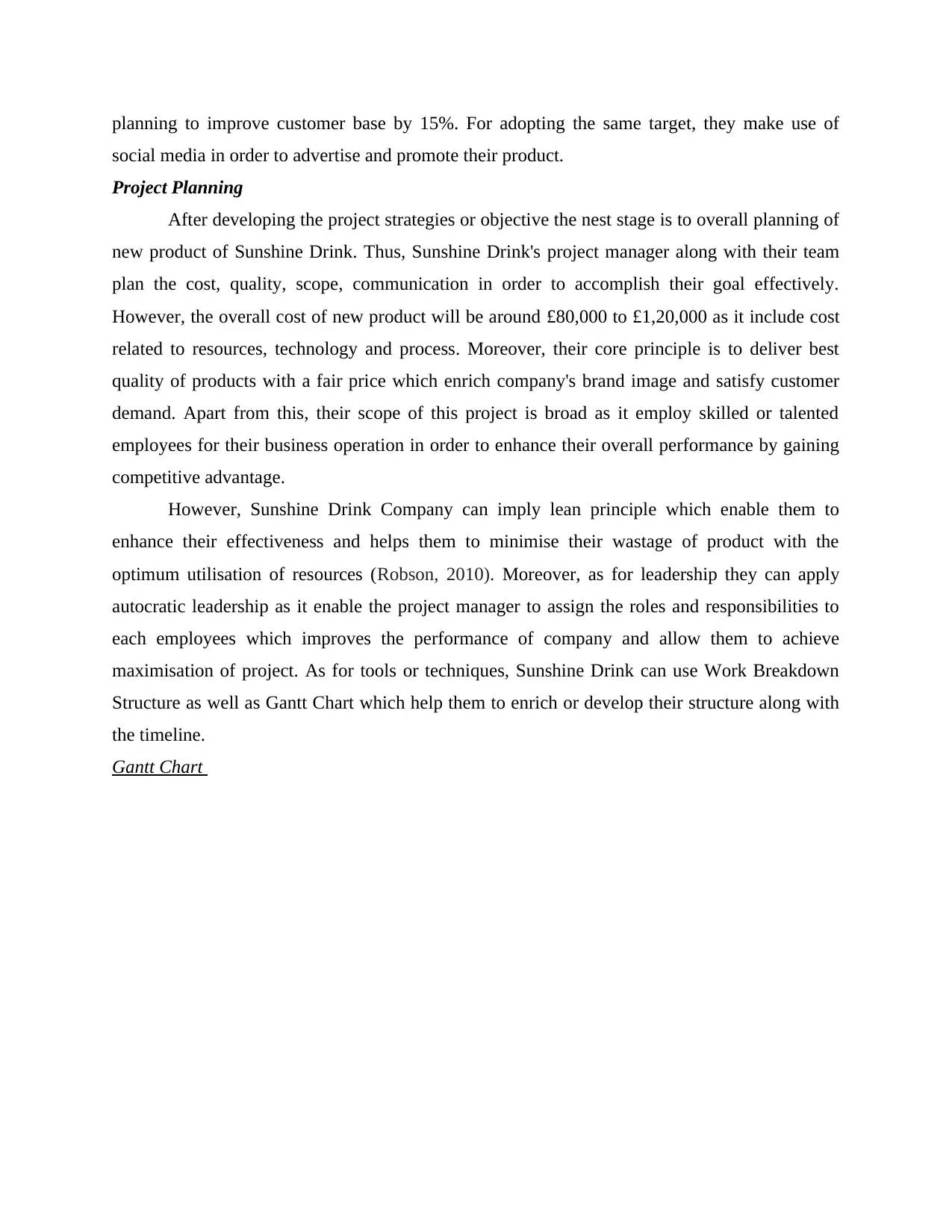
planning to improve customer base by 15%. For adopting the same target, they make use of
social media in order to advertise and promote their product.
Project Planning
After developing the project strategies or objective the nest stage is to overall planning of
new product of Sunshine Drink. Thus, Sunshine Drink's project manager along with their team
plan the cost, quality, scope, communication in order to accomplish their goal effectively.
However, the overall cost of new product will be around £80,000 to £1,20,000 as it include cost
related to resources, technology and process. Moreover, their core principle is to deliver best
quality of products with a fair price which enrich company's brand image and satisfy customer
demand. Apart from this, their scope of this project is broad as it employ skilled or talented
employees for their business operation in order to enhance their overall performance by gaining
competitive advantage.
However, Sunshine Drink Company can imply lean principle which enable them to
enhance their effectiveness and helps them to minimise their wastage of product with the
optimum utilisation of resources (Robson, 2010). Moreover, as for leadership they can apply
autocratic leadership as it enable the project manager to assign the roles and responsibilities to
each employees which improves the performance of company and allow them to achieve
maximisation of project. As for tools or techniques, Sunshine Drink can use Work Breakdown
Structure as well as Gantt Chart which help them to enrich or develop their structure along with
the timeline.
Gantt Chart
social media in order to advertise and promote their product.
Project Planning
After developing the project strategies or objective the nest stage is to overall planning of
new product of Sunshine Drink. Thus, Sunshine Drink's project manager along with their team
plan the cost, quality, scope, communication in order to accomplish their goal effectively.
However, the overall cost of new product will be around £80,000 to £1,20,000 as it include cost
related to resources, technology and process. Moreover, their core principle is to deliver best
quality of products with a fair price which enrich company's brand image and satisfy customer
demand. Apart from this, their scope of this project is broad as it employ skilled or talented
employees for their business operation in order to enhance their overall performance by gaining
competitive advantage.
However, Sunshine Drink Company can imply lean principle which enable them to
enhance their effectiveness and helps them to minimise their wastage of product with the
optimum utilisation of resources (Robson, 2010). Moreover, as for leadership they can apply
autocratic leadership as it enable the project manager to assign the roles and responsibilities to
each employees which improves the performance of company and allow them to achieve
maximisation of project. As for tools or techniques, Sunshine Drink can use Work Breakdown
Structure as well as Gantt Chart which help them to enrich or develop their structure along with
the timeline.
Gantt Chart
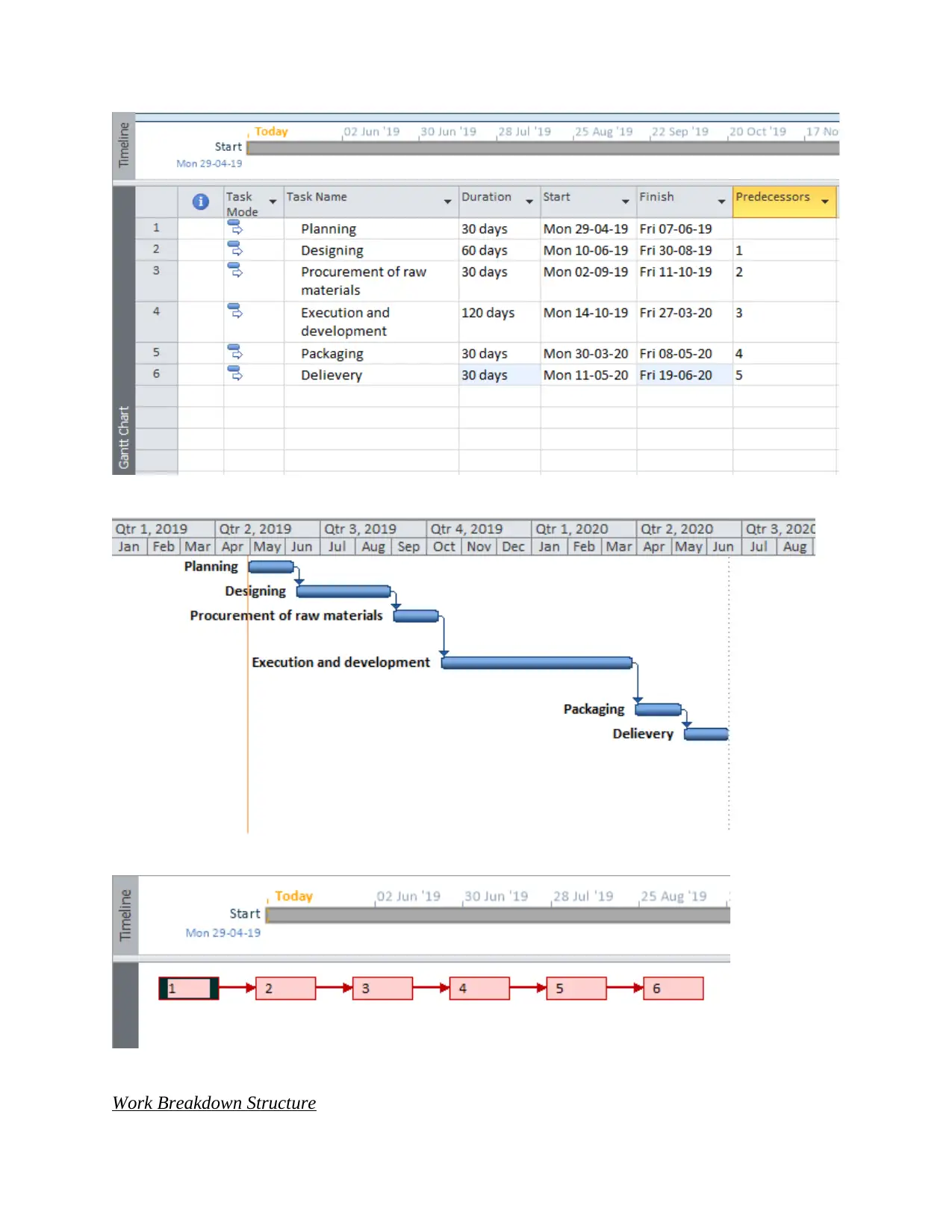
Work Breakdown Structure

Project Execution
It is regarded as third stage of project life cycle as it is responsible with the execution of
plan in order to achieve business goal or objective in an effective manner (Oakland, 2014).
However, Sunshine Drink Company's project manager assign the appropriate roles and task
according to the potentiality of employees which builds healthy working condition and their will
be less conflict of interest among subordinates. Moreover, one team take care of procurement or
acquisition of raw material on the other hand another team group takes responsibility of
developing flavours with the natural spring water. In order to generate strong working culture,
It is regarded as third stage of project life cycle as it is responsible with the execution of
plan in order to achieve business goal or objective in an effective manner (Oakland, 2014).
However, Sunshine Drink Company's project manager assign the appropriate roles and task
according to the potentiality of employees which builds healthy working condition and their will
be less conflict of interest among subordinates. Moreover, one team take care of procurement or
acquisition of raw material on the other hand another team group takes responsibility of
developing flavours with the natural spring water. In order to generate strong working culture,
Paraphrase This Document
Need a fresh take? Get an instant paraphrase of this document with our AI Paraphraser

Sunshine Drink can provide proper training to employees and develop their skills as well as
monitor or supervise the performance of subordinates which create healthy and strong working
condition. The company can apply tools like PoofHub and Zoho project as it guide them in
overall execution process.
Project closure
It is the last stage of project life cycle in which Sunshine Drink introduce their plan into
marketplace by proper utilisation of resources in order to obtain maximisation of profit in an
impressive and productive manner.
B. Review and Critique of effectiveness of PLC
Project Life Cycle is an essential component for an organisation as it guide the company
and provide proper direction in order to attain high profitability and productivity. Along with
this, it enable the company to monitor or supervise their entire business operation and helps them
to achieve organisational goal. However, project life cycle helps Sunshine Drink to enhance their
overall performance by adapting appropriate techniques or method that improves company's
brand image. In order to achieve their task in an effective manner, Sunshine Drink Company
applies Waterfall model which is described below:
Requirements: In this stage, it is concerned with analysing or evaluating the requirements
of resources for carry forward the project. Thus, project life cycle enabled the sunshine drink
company to identify their desired resources for their project. Moreover, they applied Six sigma
which helped them, in defining deliverables (Rabetino and et. al., 2015).
Design: Under this stage, it states the overall design of an project which defines the plan,
communication, strategy etc. Hence, project life cycle applies lean principles which help them to
minimise wastage of product and encourage them to imply autocratic leadership which allow
them to accomplish their organisational goal or purpose in an effective manner.
Development: This stage represent the development and implementation of plan or
process. However, Sunshine Drink company applies total quality management and just in time
principle which allow them to enrich their efficiency by reducing wastage of product as well as it
helps them to save time, cost and money.
Testing and maintenance: The final step of this waterfall model is to maintain the overall
performance of company. Thus, Sunshine Drink company applied effective leadership strategy
monitor or supervise the performance of subordinates which create healthy and strong working
condition. The company can apply tools like PoofHub and Zoho project as it guide them in
overall execution process.
Project closure
It is the last stage of project life cycle in which Sunshine Drink introduce their plan into
marketplace by proper utilisation of resources in order to obtain maximisation of profit in an
impressive and productive manner.
B. Review and Critique of effectiveness of PLC
Project Life Cycle is an essential component for an organisation as it guide the company
and provide proper direction in order to attain high profitability and productivity. Along with
this, it enable the company to monitor or supervise their entire business operation and helps them
to achieve organisational goal. However, project life cycle helps Sunshine Drink to enhance their
overall performance by adapting appropriate techniques or method that improves company's
brand image. In order to achieve their task in an effective manner, Sunshine Drink Company
applies Waterfall model which is described below:
Requirements: In this stage, it is concerned with analysing or evaluating the requirements
of resources for carry forward the project. Thus, project life cycle enabled the sunshine drink
company to identify their desired resources for their project. Moreover, they applied Six sigma
which helped them, in defining deliverables (Rabetino and et. al., 2015).
Design: Under this stage, it states the overall design of an project which defines the plan,
communication, strategy etc. Hence, project life cycle applies lean principles which help them to
minimise wastage of product and encourage them to imply autocratic leadership which allow
them to accomplish their organisational goal or purpose in an effective manner.
Development: This stage represent the development and implementation of plan or
process. However, Sunshine Drink company applies total quality management and just in time
principle which allow them to enrich their efficiency by reducing wastage of product as well as it
helps them to save time, cost and money.
Testing and maintenance: The final step of this waterfall model is to maintain the overall
performance of company. Thus, Sunshine Drink company applied effective leadership strategy
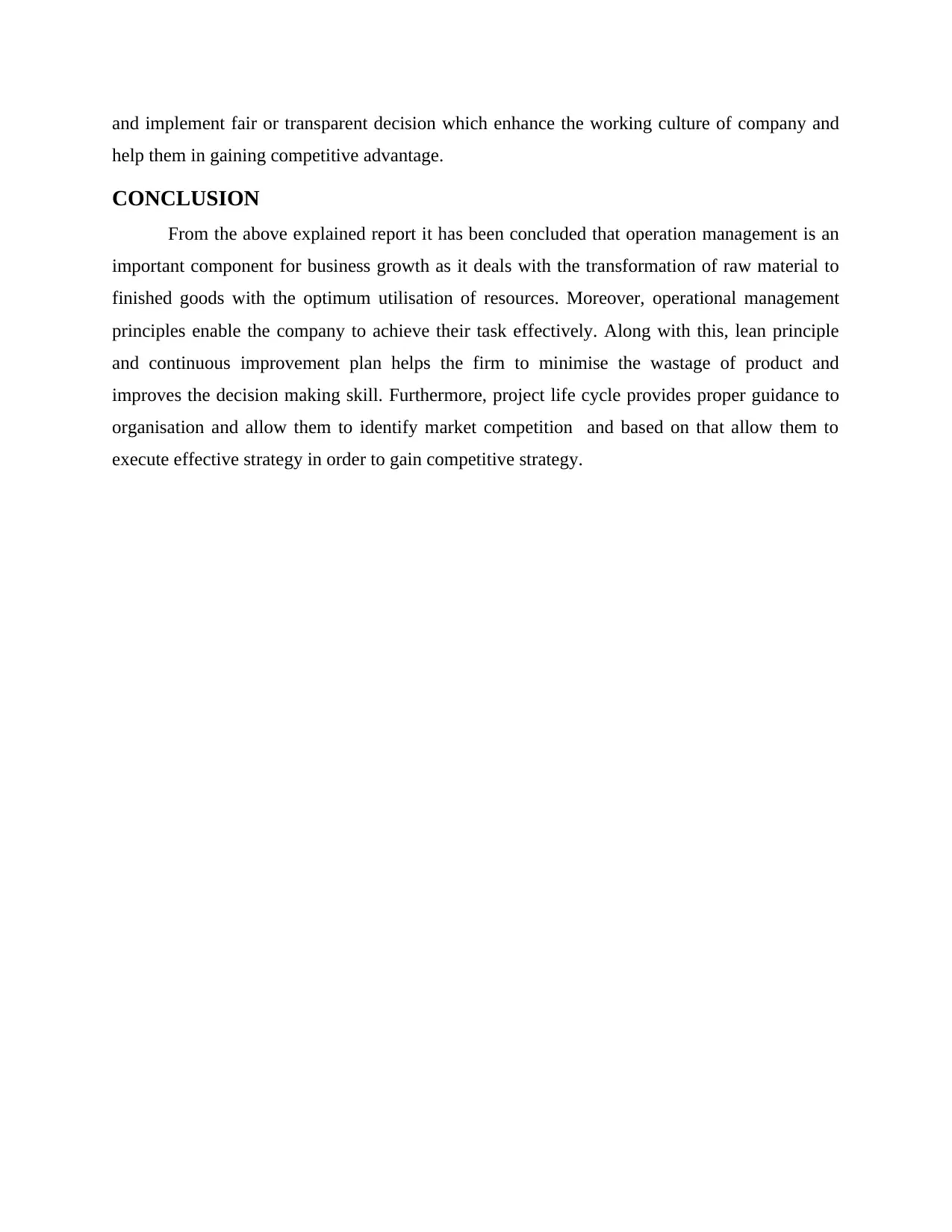
and implement fair or transparent decision which enhance the working culture of company and
help them in gaining competitive advantage.
CONCLUSION
From the above explained report it has been concluded that operation management is an
important component for business growth as it deals with the transformation of raw material to
finished goods with the optimum utilisation of resources. Moreover, operational management
principles enable the company to achieve their task effectively. Along with this, lean principle
and continuous improvement plan helps the firm to minimise the wastage of product and
improves the decision making skill. Furthermore, project life cycle provides proper guidance to
organisation and allow them to identify market competition and based on that allow them to
execute effective strategy in order to gain competitive strategy.
help them in gaining competitive advantage.
CONCLUSION
From the above explained report it has been concluded that operation management is an
important component for business growth as it deals with the transformation of raw material to
finished goods with the optimum utilisation of resources. Moreover, operational management
principles enable the company to achieve their task effectively. Along with this, lean principle
and continuous improvement plan helps the firm to minimise the wastage of product and
improves the decision making skill. Furthermore, project life cycle provides proper guidance to
organisation and allow them to identify market competition and based on that allow them to
execute effective strategy in order to gain competitive strategy.

REFERENCES
Books and Journals
Baird, K., Jia Hu, K. and Reeve, R., 2011. The relationships between organizational culture, total
quality management practices and operational performance. International Journal of
Operations & Production Management. 31(7). pp.789-814.
Burke, R., 2013. Project management: planning and control techniques.mNew Jersey, USA.
Elbashir, M.Z., Collier, P.A. and Sutton, S.G., 2011. The role of organizational absorptive
capacity in strategic use of business intelligence to support integrated management
control systems. The Accounting Review. 86(1). pp.155-184.
Guerriero, F. and Guido, R., 2011. Operational research in the management of the operating
theatre: a survey. Health care management science. 14(1). pp.89-114.
Jevgeni, S., Eduard, S. and Roman, Z., 2015. Framework for continuous improvement of
production processes and product throughput. Procedia Engineering. 100.pp.511-519.
Katsanevakis, S., and et. al., 2011. Ecosystem-based marine spatial management: review of
concepts, policies, tools, and critical issues. Ocean & Coastal Management. 54(11).
pp.807-820.
Manoharan, T.R., Muralidharan, C. and Deshmukh, S.G., 2012. A composite model for
employees' performance appraisal and improvement. European Journal of Training and
Development. 36(4). pp.448-480.
Meredith, J.R. and Mantel Jr, S.J., 2011. Project management: a managerial approach. John
Wiley & Sons.
Monroe, K., Fick, F. and Joshi, M., 2012. Successful integration of ergonomics into continuous
improvement initiatives. Work. 41(Supplement 1), pp.1622-1624.
O’Regan, G., 2017. Software process improvement. InConcise Guide to Software Engineering
(pp. 239-254). Springer, Cham.
Oakland, J.S., 2014. Total quality management and operational excellence: text with cases.
Routledge.
Rabetino, R., and et. al., 2015. Developing the concept of life-cycle service offering. Industrial
Marketing Management. 49. pp.53-66.
Robson, G.D., 2010. Continuous process improvement. Simon and Schuster.
Sroka, W. and Hittmár, Š., 2013. Management of alliance networks: Formation, functionality,
and post operational strategies. Springer Science & Business Media.
Stark, J., 2015. Product lifecycle management. In Product lifecycle management (Volume 1) (pp.
1-29). Springer, Cham.
Books and Journals
Baird, K., Jia Hu, K. and Reeve, R., 2011. The relationships between organizational culture, total
quality management practices and operational performance. International Journal of
Operations & Production Management. 31(7). pp.789-814.
Burke, R., 2013. Project management: planning and control techniques.mNew Jersey, USA.
Elbashir, M.Z., Collier, P.A. and Sutton, S.G., 2011. The role of organizational absorptive
capacity in strategic use of business intelligence to support integrated management
control systems. The Accounting Review. 86(1). pp.155-184.
Guerriero, F. and Guido, R., 2011. Operational research in the management of the operating
theatre: a survey. Health care management science. 14(1). pp.89-114.
Jevgeni, S., Eduard, S. and Roman, Z., 2015. Framework for continuous improvement of
production processes and product throughput. Procedia Engineering. 100.pp.511-519.
Katsanevakis, S., and et. al., 2011. Ecosystem-based marine spatial management: review of
concepts, policies, tools, and critical issues. Ocean & Coastal Management. 54(11).
pp.807-820.
Manoharan, T.R., Muralidharan, C. and Deshmukh, S.G., 2012. A composite model for
employees' performance appraisal and improvement. European Journal of Training and
Development. 36(4). pp.448-480.
Meredith, J.R. and Mantel Jr, S.J., 2011. Project management: a managerial approach. John
Wiley & Sons.
Monroe, K., Fick, F. and Joshi, M., 2012. Successful integration of ergonomics into continuous
improvement initiatives. Work. 41(Supplement 1), pp.1622-1624.
O’Regan, G., 2017. Software process improvement. InConcise Guide to Software Engineering
(pp. 239-254). Springer, Cham.
Oakland, J.S., 2014. Total quality management and operational excellence: text with cases.
Routledge.
Rabetino, R., and et. al., 2015. Developing the concept of life-cycle service offering. Industrial
Marketing Management. 49. pp.53-66.
Robson, G.D., 2010. Continuous process improvement. Simon and Schuster.
Sroka, W. and Hittmár, Š., 2013. Management of alliance networks: Formation, functionality,
and post operational strategies. Springer Science & Business Media.
Stark, J., 2015. Product lifecycle management. In Product lifecycle management (Volume 1) (pp.
1-29). Springer, Cham.
Secure Best Marks with AI Grader
Need help grading? Try our AI Grader for instant feedback on your assignments.

2
1 out of 17
Your All-in-One AI-Powered Toolkit for Academic Success.
+13062052269
info@desklib.com
Available 24*7 on WhatsApp / Email
![[object Object]](/_next/static/media/star-bottom.7253800d.svg)
Unlock your academic potential
© 2024 | Zucol Services PVT LTD | All rights reserved.





